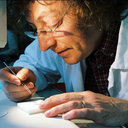The intrahepatic biliary epithelium in the guinea pig: is hepatic artery blood flow essential in maintaining its function and structure?
Słowa kluczowe
Abstrakcyjny
To determine whether hepatic artery blood flow is essential in maintaining the function and structure of bile ductules/ducts, the acute effects of hepatic artery ligation on bile secretion and hepatic ultrastructure were examined in anesthetized, bile duct-cannulated guinea pigs. Sixty minutes after hepatic artery ligation, spontaneous bile flow (5.08 +/- 0.4 microliter per min per gm liver) was virtually the same as that before hepatic artery ligation (5.31 +/- 0.3 microliter per min per gm), as were the choleretic effects of 10 CU per kg per 30 min secretin (7.14 +/- 0.9 vs. 7.21 +/- 0.9 microliter per min per gm), 300 micrograms per kg per 30 min glucagon (6.72 +/- 0.9 vs. 6.59 +/- 0.8 microliter per min per gm) and 60 mumoles per kg per 30 min glycochenodeoxycholate (6.43 +/- 0.6 vs. 6.45 +/- 0.6 microliter per min per gm). The failure of hepatic artery ligation to affect bile secretory function could not be attributed to the existence of collateral arterial blood flow to the liver. First of all, hepatic artery ligation resulted in diminishing significantly hepatic venous, but not portal, oxygen content. More importantly, in isolated guinea pig livers, perfused through the portal vein alone, secretin, glucagon and glycochenodeoxycholate produced changes in bile flow and composition similar to those seen in vivo. Electron microscopy showed no major ultrastructural changes of hepatic parenchyma and biliary epithelium 2 hr after hepatic artery ligation, or 2 hr after perfusing the liver through the portal vein alone save for some portal edema in the latter instance.(ABSTRACT TRUNCATED AT 250 WORDS)


